Measurement Models: Exploratory and Confirmatory Factor Analysis - PowerPoint PPT Presentation
1 / 27
Title:
Measurement Models: Exploratory and Confirmatory Factor Analysis
Description:
Requires a specific operational definition. Indicators of the construct need to be selected ... Survey of teacher stress, job satisfaction and career commitment ... – PowerPoint PPT presentation
Number of Views:92
Avg rating:3.0/5.0
Title: Measurement Models: Exploratory and Confirmatory Factor Analysis
1
Measurement Models Exploratory and Confirmatory
Factor Analysis
- James G. Anderson, Ph.D.
- Purdue University
2
Conceptual Nature of Latent Variables
- Latent variables correspond to some type of
hypothetical construct - Requires a specific operational definition
- Indicators of the construct need to be selected
- Data from the indicators must be consistent with
certain predictions (e.g., moderately correlated
with one another)
3
Multi-Indicator Approach
- A multiple-indicator approach reduces the overall
effect of measurement error of any individual
observed variable on the accuracy of the results - A distinction is made between observed variables
(indicators) and underlying latent variables
(constructs) - Together the observed variables and the latent
variables make up the measurement model
4
Principles of Measurement
- Reliability is concerned with random error
- Validity is concerned with random and systematic
error
5
Measurement Reliability
- Test-Retest
- Alternate Forms
- Split-Half/Internal Consistency
- Inter-rater
- Coefficient
- 0.90 Excellent
- 0.80 Very Good
- 0.70 Adequate
- 0.50 Poor
6
Measurement Validity
- Content ( (whether an indicators items are
representative of the domain of the construct) - Criterion-Related (whether a measure relates to
an external standard against which it can be
evaluated) - Concurrent (when scores on the predictor and
criterion are collected at the same time) - Predictive (when scores on the predictor and
criterion are collected at different times) - Convergent (items that measure the same
construct are correlated with one another) - Discriminant (items that measure different
constructs are not correlated highly with one
another)
7
Types of Measurement Models
- Exploratory (EFA)
- Confirmatory (CFA)
- Multitrait-Multimethod (MTMM)
- Hierarchical CFA
8
An Exploratory Factor Model
9
EFA Features
- The potential number of factors ranges from one
up to the number of observed variables - All of the observed variables in EFA are allowed
to correlate with every factor - An EFA solution usually requires rotation to make
the factors more interpretable. Rotation changes
the correlations between the factors and the
indicators so the pattern of values is more
distinct
10
A Confirmatory Factor Model
11
CFA Features
- The number of factors and the observed variables
(indicators) that load on each construct (factor
or latent variable) are specified in advance of
the analysis - Generally indicators load on only one construct
(factor) - Each indicator is represented as having two
causes, a single factor that it is suppose to
measure and all other unique sources of variance
represented by measurement error
12
CFA Features
- The measurement error terms are independent of
each other and of the factors - All associations between factors are unanalyzed
13
A Covariance Structure Model
14
A Structural Model of the Dimensions of Teacher
Stress
- Survey of teacher stress, job satisfaction and
career commitment - 710 primary school teachers in the U.K.
15
Methods
- 20-Item survey of teacher stress
- EFA (N355)
- CFA (N375)
- 1-Item overall self-rating of stress
- SEM (N710)
16
Table1 An oblique five factor pattern solution
(N170)
17
Factor Patterns
18
EFA Results
- 5 Factor solution
- 4 Items deleted
- Fit Statistics
- Chi Square 156.94
- df 70
- AGFI 0.906
- RMR 0.053
19
Confirmatory Factor Analysis
20
Covariances between exogenous latent traits
21
CFA Results
- 5 Factor solution
- 2 Items deleted
- Fit Statistics
- Chi Square 171.14
- df 70
- AGFI 0.911
- RMR 0.057
22
Structural Equation Models
- True Null Model - Hypothesizes no significant
covariances among the observed variables - Structural Null Model - Hypothesizes no
significant structural or correlational relations
among the latent variables - Non-Recursive Model
- Mediated Model
- Regression Model
23
Non-recursive model
24
Regression Model
25
Comparison of Fit Indices
26
Results
- Two major contributors to teacher stress
- Work load
- Student Misbehavior
27
Confirmatory Factor Analysis with SIMPLIS































